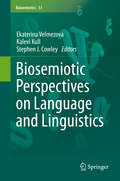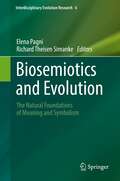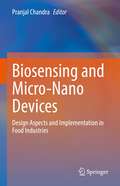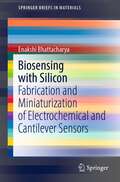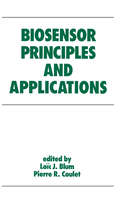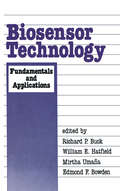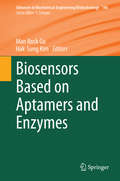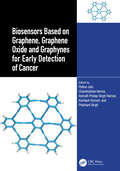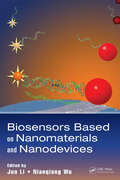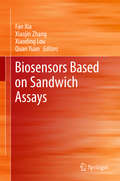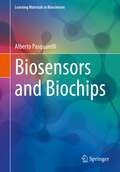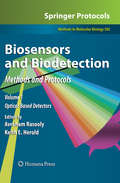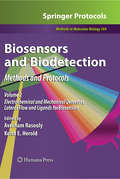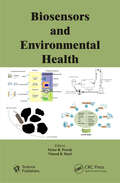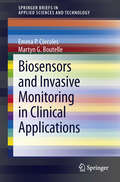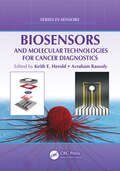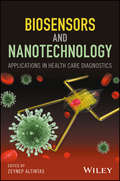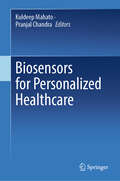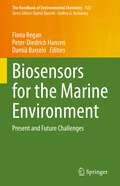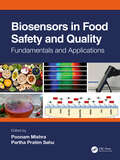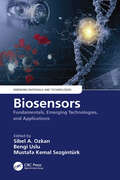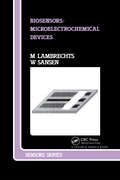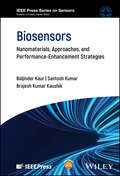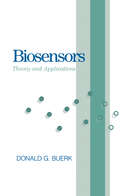- Table View
- List View
Biosemiotic Perspectives on Language and Linguistics (Biosemiotics #13)
by Ekaterina Velmezova Kalevi Kull Stephen J. CowleyThe first international volume on the topic of biosemiotics and linguistics. It aims to establish a new relationship between linguistics and biology as based on shared semiotic foundation.
Biosemiotics and Evolution: The Natural Foundations of Meaning and Symbolism (Interdisciplinary Evolution Research #6)
by Elena Pagni Richard Theisen SimankeThis book reviews the evolution of Biosemiotics and gives an outlook on the future of this interdisciplinary new discipline. In this volume, the foundations of symbolism are transformed into a phenomenological, technological, philosophical and psychological discussion enriching the readers’ knowledge of these foundations. It offers the opportunity to rethink the impact that evolution theory and the confirmations about evolution as a historical and natural fact, has had and continues to have today. The book is divided into three parts:Part I Life, Meaning, and InformationPart II Semiosis and EvolutionPart III Physics, medicine, and bioenergetics It starts by laying out a general historical, philosophical, and scientific framework for the collection of studies that will follow. In the following some of the main reference models of evolutionary theories are revisited: Extended Synthesis, Formal Darwinism and Biosemiotics. The authors shed new light on how to rethink the processes underlying the origins and evolution of knowledge, the boundary between teleonomic and teleological paradigms of evolution and their possible integration, the relationship between linguistics and biological sciences, especially with reference to the concept of causality, biological information and the mechanisms of its transmission, the difference between physical and biosemiotic intentionality, as well as an examination of the results offered or deriving from the application in the economics and the engineering of design, of biosemiotic models for the transmission of culture, digitalization and proto-design. This volume is of fundamental scientific and philosophical interest, and seen as a possibility for a dialogue based on theoretical and methodological pluralism. The international nature of the publication, with contributions from all over the world, will allow a further development of academic relations, at the service of the international scientific and humanistic heritage.
Biosensing and Micro-Nano Devices: Design Aspects and Implementation in Food Industries
by Pranjal ChandraThis book reviews applications of nanomaterial and nanodevices in the food industry. It also discusses the advanced bioanalytical techniques, including Enzyme-Linked Immunosorbent Assay (ELISA), immunoanalytical techniques, and monoclonal antibody-based immunological techniques for detecting food adulterations and allergens. It comprehensively covers electrode modification and nano-engineered fabrication of biosensors to enhance their functionalities for utilization in food industries. The book highlights the utilization of nanobiosensors for food safety and quality analysis, such as detection of toxin, food-borne pathogen, allergen, evaluation of toxicity etc. Further, it also summarizes the recent advances in nanodevices such as nano-systems, nano-emulsions, nanopesticides, and nanocapsules and their applications in the food industry. Lastly, it covers nanomaterial-based sensors for drug analysis in diverse matrices. It serves as an invaluable source of information for professionals, researchers, academicians, and students related to food science and technology.
Biosensing with Silicon: Fabrication and Miniaturization of Electrochemical and Cantilever Sensors (SpringerBriefs in Materials)
by Enakshi BhattacharyaThis book discusses two silicon biosensors: an electrochemical sensor – the Electrolyte Insulator Silicon Capacitor (EISCAP), and a mechanical resonant cantilever sensor. The author presents the principle and the technology behind the device fabrication and miniaturization, stable and reproducible functionalization protocols for bioreceptor immobilization, and the measurement and the data analysis for extracting the best performance from these sensors.EISCAP sensors, used for the estimation of triglycerides and urea, have been improved through the use of micromachining processes. The miniaturization brought out advantages as well as challenges which are discussed in this book, resulting in a prototype mini-EISCAP with a readout circuit for fast and accurate estimation of triglycerides. The author also reports on the sensitivity improvements in the estimation of triglycerides and urea obtained with the polycrystalline silicon cantilever and its measurements in liquid media.The book is ideal for materials scientists and engineers working in the field of biosensors and MicroElectroMechanical systems (MEMS) and their optimizations, as well as researchers with biochemical or biomedical expertise, in order to have a fresh and updated review on the last progresses reached with EISCAPs and cantilever sensors.
Biosensor Principles and Applications (Biotechnology And Bioprocessing Ser.)
by Pierre R. Coulet Loïc J. BlumConsiders a new generation of sensors for use in industrial processes, which measure the chemical environment directly by means of a biological agent mainly enzymes so far. Various specialists from Europe, the US, and Japan identify the device's place in their disciplines; review the principles of m
Biosensor Technology: Fundamentals and Applications
by BuckThis authoritative reference covers recent advances in the field, stressing an interdisciplinaryapproach to the development and use of biosensor technology in physics,engineering, analytical chemistry, and biochemistry (including immunochemistry).about the editors ...RICHARD P. BucK is a Professor in the Chemistry Department, University of Northcarolina, Chapel Hill. Professor Buck serves on the editorial boards of severaljournals including Analytical Instrumentation: Applications and Designs for Chemica~Biomedica~ and Environmental Science (Marcel Dekker, Inc.). He is a member of theAmerican Chemical Society, Electrochemical Society, and International Society ofElectrochemistry. He received the B.S. (1950) and M.S. (1951) degrees from thecalifornia Institute of Tochnology, Pasadena, and Ph.D. degree (1954) from theMassachusetts Institute of Tochnology, cambridge.W1WAM E. HATFIELD is Mary Ann Smith Professor and Vice Chairman of Chemistry,and Acting Chairman of the Curriculum in Applied Sciences, University of Northcarolina, Chapel Hill. He is the author or coauthor of over 300 publications, andcoeditor, with John H. Miller, Jr., of High-Temperature Superconducting Materials:Preparations, Properties, and Processing (Marcel Dekker, Inc.). He is a member of theAmerican Chemical Society, American Association for the Advancement of Science,and Materials Research Society. He received the B.S. (1958) and M.S. (1959) degreesfrom Marshall University, Huntington, West Virginia, Ph.D. degree (1962) from theUniversity of Arizona, Tucson, and completed postdoctoral research at the Universityof Illinois, Urbana.M1KTHA UMANA is an independent consultant to Glaxo Inc. and Research 'IriangleInstitute, Research 'Iriangle Park, and Duke University Engineering Research Center,Durham, North carolina. The coauthor of numerous scientific journal articles, herresearch interests include surface chemistry, electrochemistry, and biosensors. Shereceived the B.Sc. degree (1969) from the University of Chile, Santiago, and Ph.D.degree (1972) from the University of London, England.EDMOND E BowoEN is an Associate Professor in the Department of Chemistry andin the Biotechnology Program, North carolina State University, Raleigh. Thecoauthor of numerous journal articles, his research interests include bioelectrochemistry,biological electron transfer, biosensors, and surface chemistry. He receivedthe B.S. degree (1970) from Syracuse University, Syracuse, New York, and Ph.D.degree (1982) from Virginia Commonwealth University, Richmond.
Biosensors Based on Aptamers and Enzymes (Advances in Biochemical Engineering/Biotechnology #140)
by Man Bock Gu Hak-Sung KimVolumes are organized topically and provide a comprehensive discussion of developments in the respective field over the past 3-5 years. The series also discusses new discoveries and applications. Special volumes are dedicated to selected topics which focus on new biotechnological products and new processes for their synthesis and purification. In general, special volumes are edited by well-known guest editors. The series editor and publisher will however always be pleased to receive suggestions and supplementary information. Manuscripts are accepted in English.
Biosensors Based on Graphene, Graphene Oxide and Graphynes for Early Detection of Cancer
by Chandrabhan Verma Pallavi Jain Prashant Singh Anirudh Pratap Singh Raman Kamlesh KumariThe detection of cancer at its earliest stages is paramount for successful treatment and improved patient outcomes. In recent years, the field of nanotechnology has witnessed significant advancements, and one material that has emerged as a potential game-changer in cancer detection is graphene. Graphene's high surface area, excellent electrical conductivity, and ability to interact with biological molecules have paved the way for innovative approaches to diagnosing cancer. Moreover, graphene oxide, a derivative of graphene, has gained significant attention in the field of cancer detection. Its unique properties, including biocompatibility and high photothermal conversion efficiency, enable its use in various imaging techniques. Graphene oxide can selectively accumulate in tumor tissues, enhancing the contrast signals in imaging modalities like optical imaging, magnetic resonance imaging (MRI), and photoacoustic imaging. This allows for precise visualization and localization of cancerous cells or tissues, aiding in early detection and accurate diagnosis.Features: Provides a comprehensive exploration of carbon, its allotropes, and its significance in emerging applications. Discusses the synthesis and functionalization of graphene on diverse substrates, and modeling approaches employed in graphene research. Details the application of graphene, graphene oxide, and graphyne-based materials on cancer detection. Explores the overview of the wider biological applications of carbon-based materials. This book will serve as a valuable reference source for researchers, academics, and biologists working in R&D and interested in biosensing for the early detection of cancer.
Biosensors Based on Nanomaterials and Nanodevices (Nanomaterials and their Applications)
by AntonioBiosensors Based on Nanomaterials and Nanodevices links interdisciplinary research from leading experts to provide graduate students, academics, researchers, and industry professionals alike with a comprehensive source for key advancements and future trends in nanostructured biosensor development. It describes the concepts, principles, materials, device fabrications, functions, system integrations, and applications of various types of biosensors based on signal transduction mechanisms, including fluorescence, photonic crystal, surface-enhanced Raman scattering, electrochemistry, electro-luminescence, field-effect transistor, and magnetic effect. The book: Explains how to utilize the unique properties of nanomaterials to construct nanostructured biosensors to achieve enhanced performance Features examples of biosensors based on both typical and emerging nanomaterials, such as gold nanoparticles, quantum dots, graphene, graphene oxides, magnetic nanoparticles, carbon nanotubes, inorganic nanowires/nanorods, plasmonic nanostructures, and photonic crystals Demonstrates the broad applications of nanostructured biosensors in environmental monitoring, food safety, industrial quality assurance, and in vitro and in vivo health diagnosis Inspires new ideas for tackling multiscale and multidisciplinary issues in developing high-performance biosensors for complex practical biomedical problems Focusing on the connection between nanomaterials research and biosensor development, Biosensors Based on Nanomaterials and Nanodevices illustrates the exciting possibilities and critical challenges of biosensors based on nanomaterials and nanodevices for future health monitoring, disease diagnosis, therapeutic treatments, and beyond.
Biosensors Based on Sandwich Assays
by Fan Xia Xiaojin Zhang Xiaoding Lou Quan YuanThis book shows the various sandwich assays that are constructed from recognition molecules, such as antibodies, oligonucleotide sequences and aptamers, developed as a result of nano- and biotechnology advances. It consists of ten chapters presenting interesting examples of these assays, organized according to the type of analytic methods (colorimetric, fluorescence, electrochemical, etc. ) and detected objects (protein, nucleic acid, small-molecule, ion, etc. ). It also includes a chapter discussing the introduction of sandwich assays as biosensors for the detection of a range of targets. It is an interesting and useful resource for a wide readership in various fields of chemical science and nanotechnology.
Biosensors and Biochips (Learning Materials in Biosciences)
by Alberto PasquarelliThis textbook describes the basic principles and mechanism of action of biosensor systems, and introduces readers to the various types of biosensors; from affinity biosensors to catalytic, optical and label-free biosensors, the most common systems are explained in detail. Dedicated advanced sections focus on biochips and genome sequencing methods as well as organs-on-a-chip. The textbook helps readers to understand the elementary components of biosensors, and to identify and illustrate each function in the biosensor information flow, from recognition to transduction and transmission. Furthermore, readers will receive guidance in critically analyzing published studies on biosensor research, helping them to develop appropriate concepts and independently propose their own solutions. The textbook is intended for master’s students in bioengineering, biophysics, biotechnology and pharmacology that need a solid grasp of biosensor system technologies and applications, as well as students in related medical technological fields.
Biosensors and Biodetection - Methods and Protocols Volume 1: Methods and Protocols Volume 1: Optical-Based Detectors (Methods in Molecular Biology #503)
by Keith Herold Avraham RasoolyBiosensors combine biological recognition elements and signal conversion elements into a biodetection system. They have been developed for a wide variety of biodetection applications, offering the advantages of increased speed and ease of use compared to traditional detection methods. In Biosensors and Biodetection: Methods and Protocols, leading experts describe the major technologies in the field in extensive technical detail, allowing readers both to understand the technology and to construct similar devices. Volume 1: Optical-Based Detectors delves into direct and indirect optical detectors, including methods involving surface plasmon resonance, interferometric sensors, CCD based detectors, and spectrometers, among many other cutting-edge technologies. Written in the highly successful Methods in Molecular BiologyTM series format, chapters include brief introductions to the subjects, lists of the necessary materials, step-by-step, readily reproducible protocols, and Notes sections, which highlight tips on troubleshooting and avoiding known pitfalls.<P><P> Comprehensive and up-to-date, Biosensors and Biodetection: Methods and Protocols is an ideal, user-friendly guide to this vital, versatile technology and a perfect tool for those who wish to further the field.
Biosensors and Biodetection - Methods and Protocols Volume 2: Methods and Protocols Volume 2: Electrochemical and Mechanical Detectors, Lateral Flow and Ligands for Biosensors (Methods in Molecular Biology #504)
by Keith Herold Avraham RasoolyBiosensors combine biological recognition elements and signal conversion elements into a biodetection system. They have been developed for a wide variety of biodetection applications, offering the advantages of increased speed and ease of use compared to traditional detection methods. In Biosensors and Biodetection: Methods and Protocols, leading experts describe the major technologies in the field in extensive technical detail, allowing readers both to understand the technology and to construct similar devices. Volume 2: Electrochemical and Mechanical Detectors, Lateral Flow and Ligands for Biosensors focuses on direct measurement sensors, indirect methods, ligands, and related technologies, including methods involving electrochemical detectors, recognition ligands, antibodies, aptamers, and peptides, amongst many other subjects. Written in the highly successful Methods in Molecular Biology™ series format, chapters include brief introductions to the topics, lists of the necessary materials, step-by-step, readily reproducible protocols, and Notes sections, which highlight tips on troubleshooting and avoiding known pitfalls.<P><P> Comprehensive and up-to-date, Biosensors and Biodetection: Methods and Protocols is an ideal, user-friendly guide to this vital, versatile technology and a perfect tool for those who wish to further the field.
Biosensors and Environmental Health
by Victor R. Preedy Vinood B. PatelDiscussing the role biosensors play in detecting and monitoring environmental substances, Biosensors and Environmental Health provides key facts that can be applied to other areas of health and disease and a "mini-dictionary" of key terms and summary points. It covers personal toxicity testing, soil and risk assessment, pesticide, insecticides, par
Biosensors and Invasive Monitoring in Clinical Applications (SpringerBriefs in Applied Sciences and Technology)
by Martyn G. Boutelle Emma P. CórcolesThis volume examines the advances of invasive monitoring by means of biosensors and microdialysis. Physical and physiological parameters are commonly monitored in clinical settings using invasive techniques due to their positive outcome in patients' diagnosis and treatment. Biochemical parameters, however, still rely on off-line measurements and require large pieces of equipment. Biosensing and sampling devices present excellent capabilities for their use in continuous monitoring of patients' biochemical parameters. However, certain issues remain to be solved in order to ensure a more widespread use of these techniques in today's medical practices.
Biosensors and Molecular Technologies for Cancer Diagnostics (Series in Sensors)
by Avraham Rasooly Keith E. HeroldBridging the gap between research and clinical application, Biosensors and Molecular Technologies for Cancer Diagnostics explores the use of biosensors as effective alternatives to the current standard methods in cancer diagnosis and detection. It describes the major aspects involved in detecting and diagnosing cancer as well as the basic elements
Biosensors and Nanotechnology: Applications in Health Care Diagnostics
by Zeynep AltintasProvides a broad range of information from basic principles to advanced applications of biosensors and nanomaterials in health care diagnostics This book utilizes a multidisciplinary approach to provide a wide range of information on biosensors and the impact of nanotechnology on the development of biosensors for health care. It offers a solid background on biosensors, recognition receptors, biomarkers, and disease diagnostics. An overview of biosensor-based health care applications is addressed. Nanomaterial applications in biosensors and diagnostics are included, covering the application of nanoparticles, magnetic nanomaterials, quantum dots, carbon nanotubes, graphene, and molecularly imprinted nanostructures. The topic of organ-specific health care systems utilizing biosensors is also incorporated to provide deep insight into the very recent advances in disease diagnostics. Biosensors and Nanotechnology: Applications in Health Care Diagnostics is comprised of 15 chapters that are presented in four sections and written by 33 researchers who are actively working in Germany, the United Kingdom, Italy, Turkey, Denmark, Finland, Romania, Malaysia and Brazil. It covers biomarkers in healthcare; microfluidics in medical diagnostics; SPR-based biosensor techniques; piezoelectric-based biosensor technologies; MEMS-based cell counting methods; lab-on-chip platforms; optical applications for cancer cases; and more. Discusses the latest technology and advances in the field of biosensors and their applications for healthcare diagnostics Particular focus on biosensors for cancer Summarizes research of the last 30 years, relating it to state-of-the-art technologies Biosensors and Nanotechnology: Applications in Health Care Diagnostics is an excellent book for researchers, scientists, regulators, consultants, and engineers in the field, as well as for graduate students studying the subject.
Biosensors for Personalized Healthcare
by Pranjal Chandra Kuldeep MahatoThis book covers the basic principles and advanced methods used in the advancement of bioelectronics for therapeutic purposes. This book provides a thorough examination of the development and progress in bioelectronics devices and biosensors, emphasizing current improvements in individualized diagnostics using biosensing modules, tools, and approaches. It offers useful insights into the creation of biosensors for individualized healthcare diagnostics by analyzing the underlying principles of sensing methods. This book primarily emphasizes the incorporation of biosensing technologies into wearable, implantable, and biomedical devices. These advancements are transforming healthcare by enabling uninterrupted monitoring and immediate data gathering, ultimately improving patient care. The book also highlights the significance of downsizing biosensor platforms, demonstrating approaches that enhance the compactness and efficiency of these devices while maintaining their performance. The book also discusses point-of-care devices, which are of great importance. These devices are essential in clinical laboratories and care units, such as ICUs and ambulatory settings, since they provide fast, precise, and immediate diagnostic capabilities. The book showcases the most recent breakthroughs in personalized diagnostics via the use of biosensing-based bioelectronics devices, highlighting its capacity to revolutionize the provision of healthcare. This book examines the real-world uses of biosensor technology in customized healthcare throughout various chapters. It explores the customization of these devices to cater to the specific requirements of each patient, enabling accurate and prompt medical treatments. This book is a valuable resource for academics, practitioners, and enthusiasts in the subject of bioelectronics and healthcare. It combines in-depth scientific discussions with practical real-world applications. In essence, this book serves as a foundation for comprehending the profound influence of biosensor technology on personalized health care. This book encourages readers to investigate the promising opportunities that await in the field of bioelectronics, where groundbreaking devices and methods are poised to revolutionize medical diagnostics and patient treatment.
Biosensors for the Marine Environment: Present and Future Challenges (The Handbook of Environmental Chemistry #122)
by Damià Barceló Fiona Regan Peter-Diedrich HansenThis book is devoted to the exploration of innovative sensing technologies for marine applications. The book focuses on various novel biosensor designs from nano-biosensors to molecularly imprinted polymers offering a broad perspective for marine biosensors development to deployment challenges.The book aims to target researchers in the area of marine monitoring, sensor developments and deployment of devices in the marine environment.
Biosensors in Food Safety and Quality: Fundamentals and Applications
by Partha Pratim Sahu Poonam MishraBiosensors in food safety and quality have become indispensable in today’s world due to the requirement of food safety and security for human health and nutrition. This book covers various types of sensors and biosensors that can be used for food safety and food quality monitoring, but these are not limited to conventional sensors, such as temperature sensors, optical sensors, electrochemical sensors, calorimetric sensors, and pH sensors. The chapters are framed in a way that readers can experience the novel fabrication procedures of some advanced sensors, including lab-on-a-chip biosensors, IoT-based sensors, microcontroller-based sensors, and so on, particularly for fruits and vegetables, fermented products, plantation products, dairy-based products, heavy metal analysis in water, meat, fish, etc. Its simplistic presentation and pedagogical writing provide the necessary thrust and adequate information for beginners, scientists, and researchers. The book offers comprehensive coverage of the most essential topics, which include the following: Fundamentals of biosensors Overview of food safety and quality analysis Major toxicants of food and water Fabrication techniques of biosensors applicable for different segments of the food industry This book serves as a reference for scientific investigators who work on the assurance of food safety and security using biosensing principles as well as researchers developing biosensors for food analysis. It may also be used as a textbook for graduate-level courses in bioelectronics.
Biosensors: An Introductory Textbook
by Jagriti Narang C. S. PundirNanotechnology is a budding field and has a pivotal role in sensing. Nanomaterials exist in various forms such as nanoparticles, nanoclusters, nanobelts, and nanospheres. These nanomaterials act as sensing interfaces and immobilization surfaces for various biomolecules such as enzymes, DNA, and antigens. Therefore, the preparation and characterization of these nanoparticles play an important role in sensing devices. This handbook has evolved from the authors’ teaching and research experience in the field of nanoparticle biosensing. It encompasses protocols for the synthesis of various forms of metal oxide nanoparticles; study of the various characterizing techniques that help deduce the shape, size, and morphology of these nanoparticles; and applications of these nanoparticles in the field of biosensors. It presents voltammetry techniques such as cyclic, linear wave, wave pulse, and differential pulse voltammetry, throws light on the interactions of nanomaterials and biomolecules, and discusses microfluidic devices, which due to their unique capability of miniaturization fascinate many researchers. It is a practical and user-friendly textbook that introduces the various basic principles and practical information that will help undergraduate and advanced-level students and researchers understand the science behind nanoscale sensing.
Biosensors: Fundamentals, Emerging Technologies, and Applications (Emerging Materials and Technologies)
by Sibel A. Ozkan Bengi Uslu Mustafa Kemal SezgintürkBiosensors: Fundamentals, Emerging Technologies, and Applications provides insight into the sensing applications of different types of biosensors relating to environmental pollutants, microbiological analysis, and healthcare. It describes state-of-the-art research in biosensors, point of care testing, potential applications, as well as future prospects for biosensors. This book: Presents the essentials that readers need to know to make full use of biosensor technology Discusses recent perspectives on optical and electrochemical biosensors Details biosensor types for medical applications Teaches how to use enzymes for biological recognition in biomarker assays Proposes innovations in wearable and smart biosensors This book is aimed at advanced students, researchers, and academics across a broad interdisciplinary field including biochemical, pharmaceutical, and environmental engineering as well as materials science, analytical chemistry, and biosciences.
Biosensors: Microelectrochemical Devices
by M Lambrechts W SansenBiosensors are analytical devices that combine a biologically sensitive element with a physical or chemical transducer to selectively and quantitatively detect the presence of specific compounds. Balancing basics, principles, and case studies, Biosensors: Microelectrochemical Devices covers the theory and applications of one class of biosensor-microelectrochemical devices. The book clearly explains microelectronic techniques used to produce these cheap, fast reacting, and disposable sensors with the aid of helpful diagrams and tables. Researchers and postgraduates active in the field of chemical sensors, analytical chemistry, or microelectronics will find this an invaluable reference.
Biosensors: Nanomaterials, Approaches, and Performance-Enhancement Strategies (IEEE Press Series on Sensors)
by Brajesh Kumar Kaushik Santosh Kumar Baljinder KaurComprehensive resource covering new technologies, materials, strategies, and recent advancements in the field of biosensing Biosensors summarizes cutting-edge technologies in biosensing, including gene editing (known as Clustered Regularly Interspaced Short Palindromic Repeat or CRISPR), quorum sensing utilizing inter and intra cell signals, two-dimensional (2D) materials and aptamer-mediated sensor designs, and more, with additional coverage of the latest materials, strategies, and advancements made in the field. Chapters are categorized on the basis of various bio-recognition elements that include aptamer, nucleic acid, enzymes, antibodies, bacteriophages, peptides, and molecular imprinted polymers. Plasmonic, surface-enhanced Raman scattering, colorimetric, fluorescence, electrochemical, magneto and piezo-electric biosensor sensing techniques are also considered. The roles of various nanomaterials, advancement in synthesis, signal enhancement strategies, and new trends for biomedical applications are also described. Current challenges, limitations, and future prospects to developing biosensors for point-of-care and clinical applications are also discussed. Written by three highly qualified authors, Biosensors includes information on: Diverse bio-receptors include nucleic acids, aptamers, enzymes, antibodies, bacteriophages, molecularly imprinted polymers, whole-cell, and techniques of immobilization Different transduction principles using bio-receptors (e.g., optical, electrochemical, piezo-electrical, and SERS) to detect microorganism, toxins, and diseases Nanomaterials synthesis, their role in biosensing, pros and cons of carbon, polymer, metals, metal oxides, and quantum dots-based nanomaterials in medical biosensing applications Biosensors is a comprehensive and complete resource on the subject for researchers and professionals in physics, chemistry, and biomedical science, research communities working in the fields of plasmonics, optics, biosensors, and nano-photonics, and students in related programs of study.
Biosensors: Theory and Applications
by Donald G. BuerkThis introductory text covers in detail the technology and applications of biosensors in their many forms. It provides an extensive survey of the basic principles, functions and applications of different categories of biosensors. The presentation is concise, systematic and well illustrated. Numerous schematics illustrate design and function.This bo
